omastar
Attributes
- Species: Omastar
- Base Experience: 173
- Height: 10
- Weight: 350
- Is Default: True
- Order: 229
- Base Happiness: 70
- Capture Rate: 45
- Color: Blue
- Egg Groups: Water1 , Water3
- Gender Rate: 1
- Has No Gender Differences
- Hatch Counter: 30
- Habitat: Sea
- Is Baby: False
- Is Legendary: False
- Is Mythical: False
- Shape: Tentacles
Stats
-
HP
-
Attack
-
Defense
-
Special Attack
-
Special Defense
-
Speed
Summary
Omastar is a Rock/Water-type Pokémon introduced in Generation I.
Type: Rock / Water
Abilities:
- Swift Swim: Doubles Omastar's Speed stat during rain.
- Shell Armor: Protects Omastar from critical hits.
- Weak Armor (Hidden Ability): Boosts Speed by two stages and lowers Defense by one stage when hit by a physical move.
Physical Characteristics:
- Omastar resembles a prehistoric mollusk with a spiral, chambered shell.
- Its shell is blue with a series of spikes lining the edge.
- It has a light beige, squid-like body with multiple appendages that protrude from its shell.
- Omastar's head has two large, protruding eyes and a beak-like mouth.
Behavior and Habitat:
- Omastar is believed to have lived in ancient seas, residing in deep oceanic waters.
- It used its strong tentacles to ensnare prey, typically smaller sea creatures, crushing them with its powerful beak.
- Fossil evidence suggests it was a formidable predator during its time.
In Battle:
- Omastar is known for its high Defense and Special Attack stats, making it a strong defensive and special attacking Pokémon.
- It can use moves like Hydro Pump and Ancient Power to leverage its dual-type advantages.
- Often utilized in rain teams due to its Swift Swim ability, which boosts its speed in rainy conditions.
- Notable moves include Surf, Ice Beam, and Shell Smash, the latter of which increases its offensive capabilities at the cost of some defenses.
- Strong against Fire, Flying, Ice, and Bug types but weak to Electric, Fighting, Grass, and Ground types.
Evolution:
- Omastar evolves from Omanyte at level 40.
- Omanyte is revived from the Helix Fossil, which is often found in areas resembling ancient seabeds.
Interesting Facts:
- Omastar is thought to be extinct, known primarily through fossils.
- It shares similarities with modern-day nautiluses but is equipped with a more aggressive predatory arsenal.
- Omastar's design is inspired by ammonites, extinct marine mollusks with spiral shells, which inhabited the seas millions of years ago.
- The Helix Fossil, from which Omastar is revived, gained cultural significance among Pokémon fans during the "Twitch Plays Pokémon" event.
Pokémon Sprites
Evolution Chain
Moves
Level Up
- Level 0: Crunch
- Level 1: Sand Attack
- Level 1: Horn Attack
- Level 1: Bite
- Level 1: Supersonic
- Level 1: Water Gun
- Level 1: Withdraw
- Level 1: Constrict
- Level 25: Mud Shot
- Level 26: Rock Throw
- Level 28: Brine
- Level 37: Protect
- Level 39: Leer
- Level 44: Spike Cannon
- Level 46: Tickle
- Level 49: Hydro Pump
- Level 54: Ancient Power
- Level 56: Rock Blast
- Level 67: Shell Smash
TM/HM
- Headbutt
- Horn Drill
- Body Slam
- Take Down
- Double Edge
- Pin Missile
- Surf
- Ice Beam
- Blizzard
- Bubble Beam
- Hyper Beam
- Submission
- Seismic Toss
- Toxic
- Rage
- Mimic
- Double Team
- Reflect
- Bide
- Waterfall
- Skull Bash
- Rest
- Substitute
- Thief
- Snore
- Curse
- Spikes
- Icy Wind
- Sandstorm
- Endure
- Rollout
- Swagger
- Attract
- Sleep Talk
- Return
- Frustration
- Hidden Power
- Rain Dance
- Rock Smash
- Whirlpool
- Hail
- Facade
- Secret Power
- Dive
- Rock Tomb
- Muddy Water
- Water Pulse
- Gyro Ball
- Natural Gift
- Toxic Spikes
- Rock Polish
- Giga Impact
- Rock Climb
- Stone Edge
- Captivate
- Stealth Rock
- Smack Down
- Round
- Scald
- Confide
- Liquidation
Breeding
Other
Flavor Text Entries
- Red: A prehistoric Pokémon that died out when its heavy shell made it impossible to catch prey.
- Blue: A prehistoric Pokémon that died out when its heavy shell made it impossible to catch prey.
- Yellow: Sharp beaks ring its mouth. Its shell was too big for it to move freely, so it became extinct.
- Gold: Apparently, it cracked SHELLDER's shell with its sharp fangs and sucked out the insides.
- Silver: Once wrapped around its prey, it never lets go. It eats the prey by tearing at it with sharp fangs.
- Crystal: Its heavy shell allowed it to reach only nearby food. This could be the reason it is extinct.
- Ruby: OMASTAR uses its tentacles to capture its prey. It is believed to have become extinct because its shell grew too large and heavy, causing its movements to become too slow and ponderous.
- Sapphire: OMASTAR uses its tentacles to capture its prey. It is believed to have become extinct because its shell grew too large and heavy, causing its movements to become too slow and ponderous.
- Emerald: An OMASTAR uses its tentacles to capture its prey. It is believed to have become extinct because its shell grew too large, making its movements slow and ponderous.
- Firered: Its tentacles are highly developed as if they are hands and feet. As soon as it ensnares prey, it bites.
- Leafgreen: Despite having strong fangs and tentacles, it went extinct when its heavy shell made it unable to catch prey.
- Diamond: It is thought that this Pokémon became extinct because its spiral shell grew too large.
- Pearl: It is thought that this Pokémon became extinct because its spiral shell grew too large.
- Platinum: It is thought that this Pokémon became extinct because its spiral shell grew too large.
- Heartgold: Apparently, it cracked SHELLDER’s shell with its sharp fangs and sucked out the insides.
- Soulsilver: Once wrapped around its prey, it never lets go. It eats the prey by tearing at it with sharp fangs.
- Black: It is thought that this Pokémon became extinct because its spiral shell grew too large.
- White: It is thought that this Pokémon became extinct because its spiral shell grew too large.
- Black-2: It is thought that this Pokémon became extinct because its spiral shell grew too large.
- White-2: It is thought that this Pokémon became extinct because its spiral shell grew too large.
- X: Its tentacles are highly developed as if they are hands and feet. As soon as it ensnares prey, it bites.
- Y: Once wrapped around its prey, it never lets go. It eats the prey by tearing at it with sharp fangs.
- Omega-Ruby: Omastar uses its tentacles to capture its prey. It is believed to have become extinct because its shell grew too large and heavy, causing its movements to become too slow and ponderous.
- Alpha-Sapphire: Omastar uses its tentacles to capture its prey. It is believed to have become extinct because its shell grew too large and heavy, causing its movements to become too slow and ponderous.
- Ultra-Sun: Its heavy shell is thought to be the reason this ancient Pokémon died out. It’s apparently a distant ancestor of Octillery.
- Ultra-Moon: It wraps its prey in its tentacles to immobilize them and then finishes them off with its sharp fangs.
- Lets-Go-Pikachu: Its sharp beak rings its mouth. Its shell was too big for it to move freely, so it became extinct.
- Lets-Go-Eevee: Its sharp beak rings its mouth. Its shell was too big for it to move freely, so it became extinct.
- Sword: Weighed down by a large and heavy shell, Omastar couldn’t move very fast. Some say it went extinct because it was unable to catch food.
- Shield: Omastar’s sharp fangs could crush rock, but the Pokémon can attack only the prey that come within reach of its tentacles.
Cards
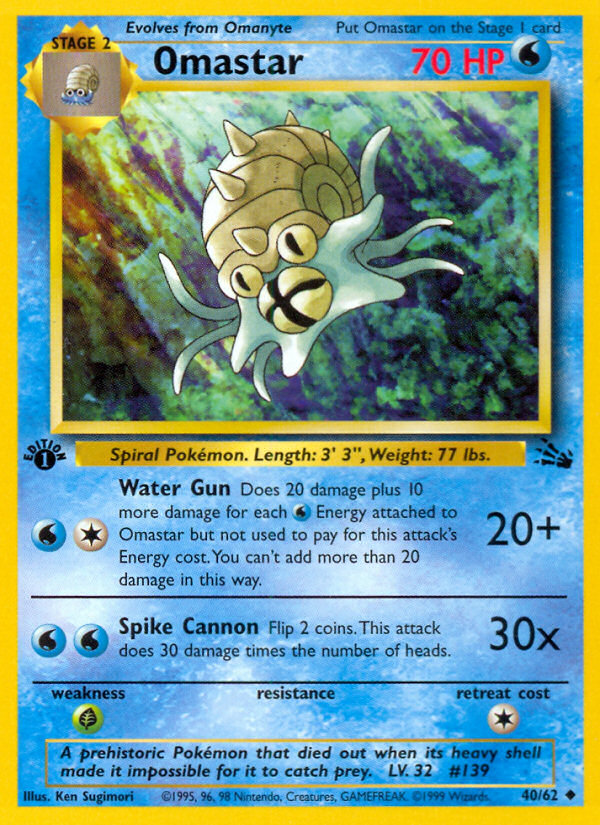
Created by Ken Sugimori for the Unknown Set set.

Created by Ken Sugimori for the Unknown Set set.

Created by Masakazu Fukuda for the Unknown Set set.
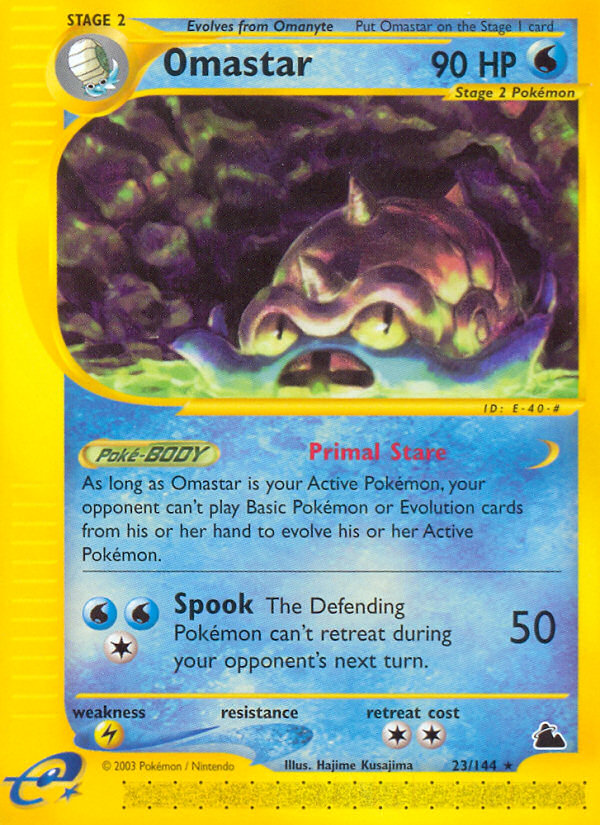
Created by Hajime Kusajima for the Unknown Set set.

Created by Mitsuhiro Arita for the Unknown Set set.
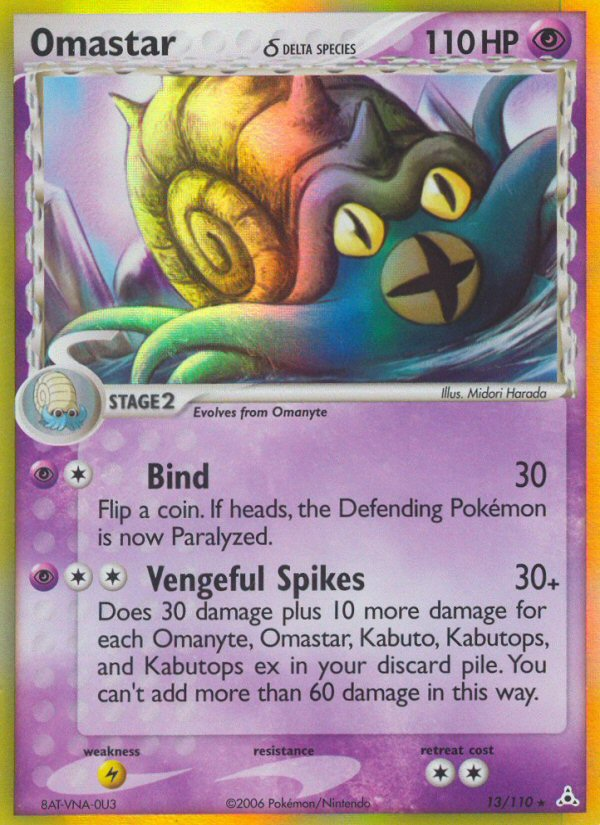
Created by Midori Harada for the Unknown Set set.
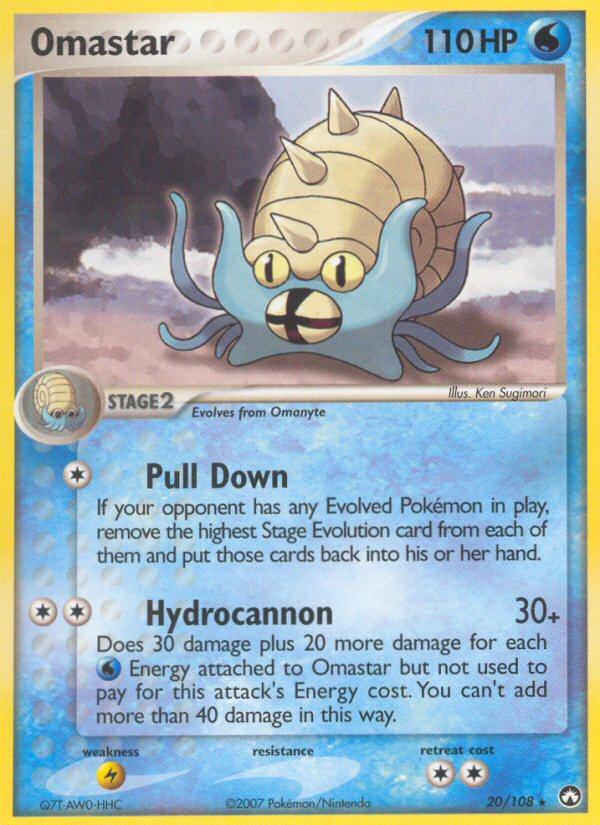
Created by Ken Sugimori for the Unknown Set set.
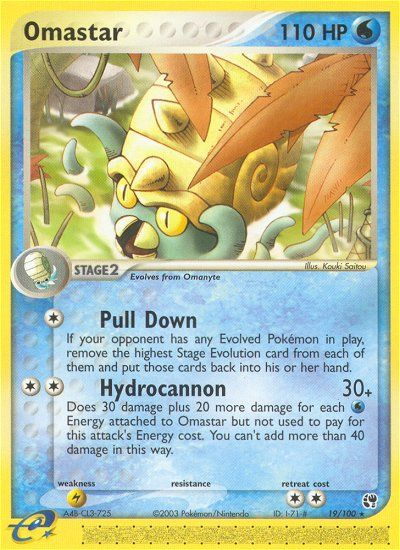
Created by Kouki Saitou for the Unknown Set set.
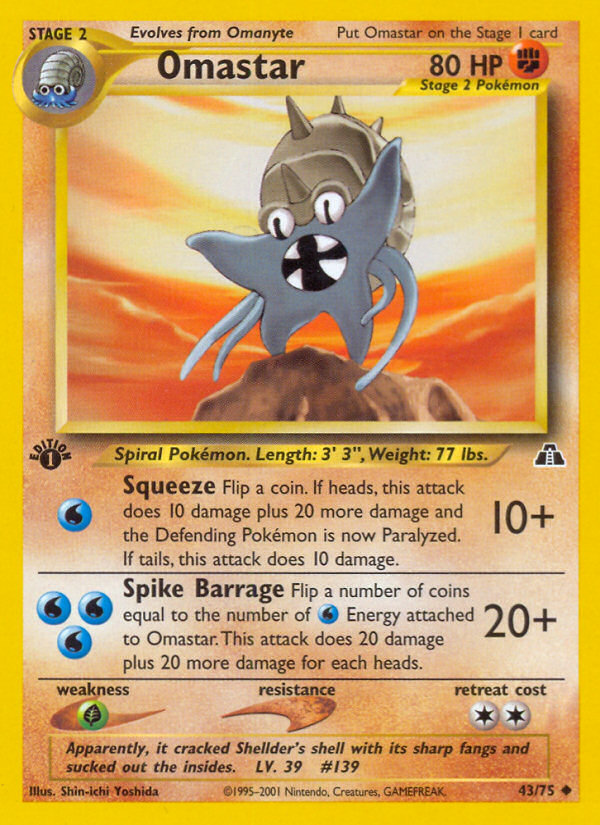
Created by Shin-Ichi Yoshida for the Unknown Set set.

Created by Tomokazu Komiya for the Unknown Set set.

Created by Hajime Kusajima for the Unknown Set set.
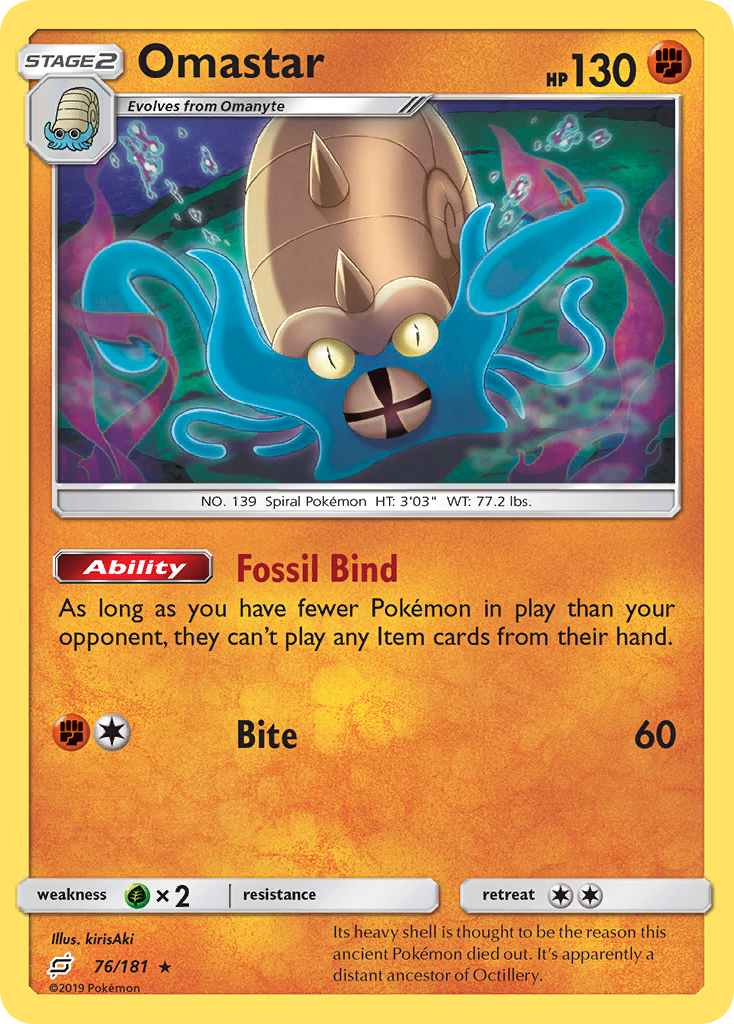
Created by Kirisaki for the Unknown Set set.
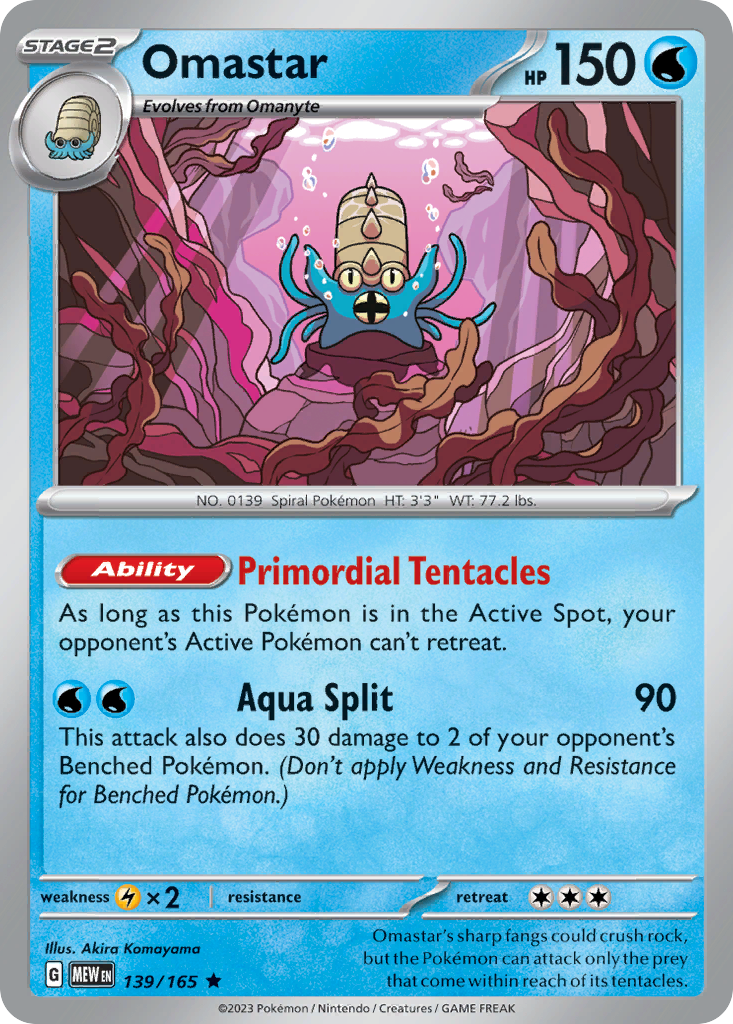
Created by Akira Komayama for the Unknown Set set.
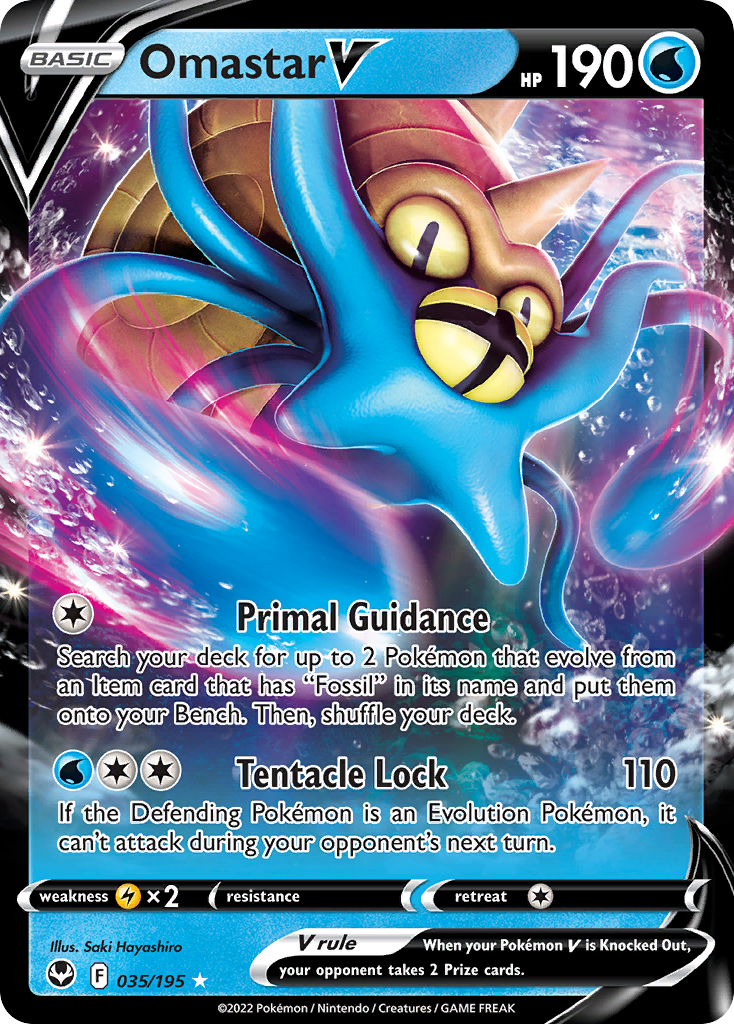
Created by Saki Hayashiro for the Unknown Set set.
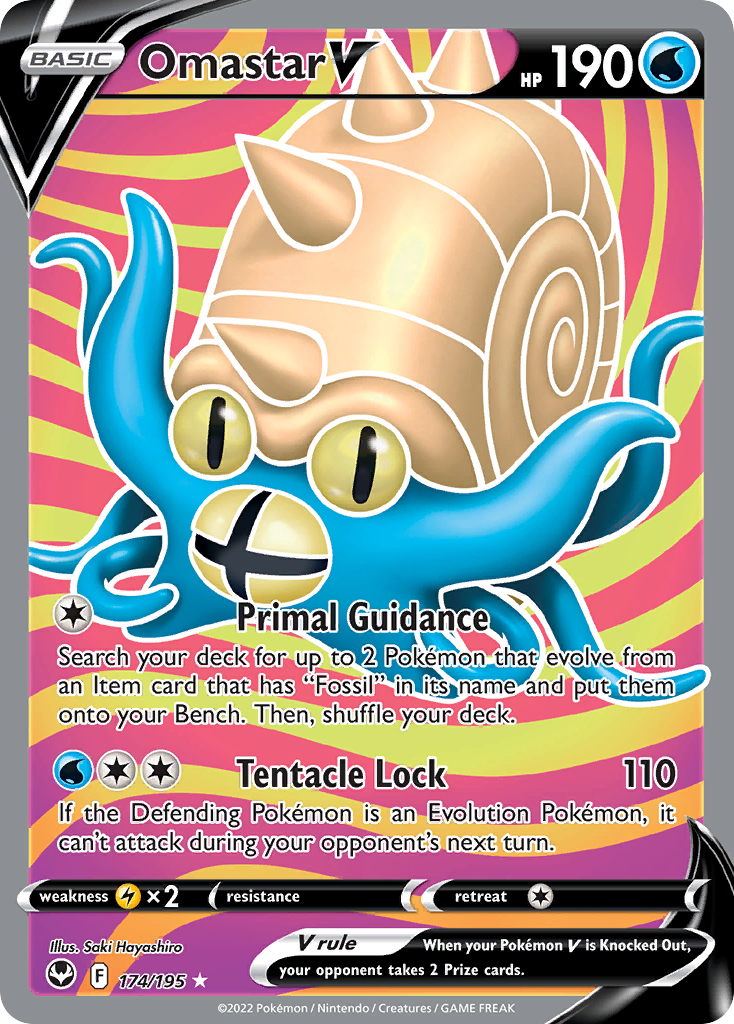
Created by Saki Hayashiro for the Unknown Set set.

Created by Hasuno for the Unknown Set set.

Created by 5ban Graphics for the Unknown Set set.